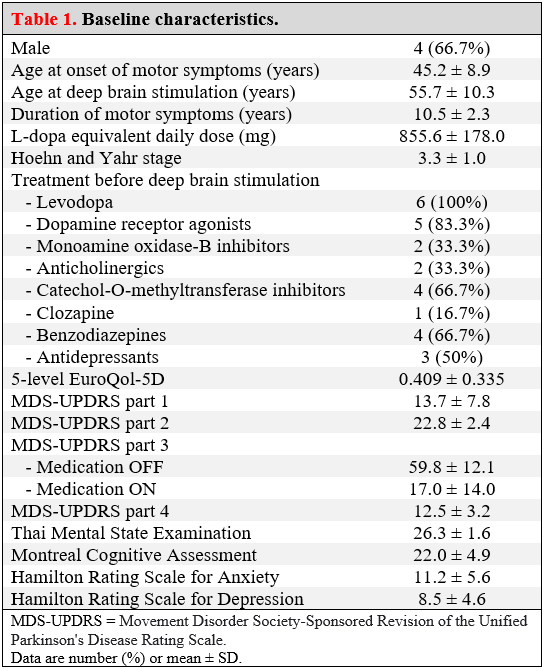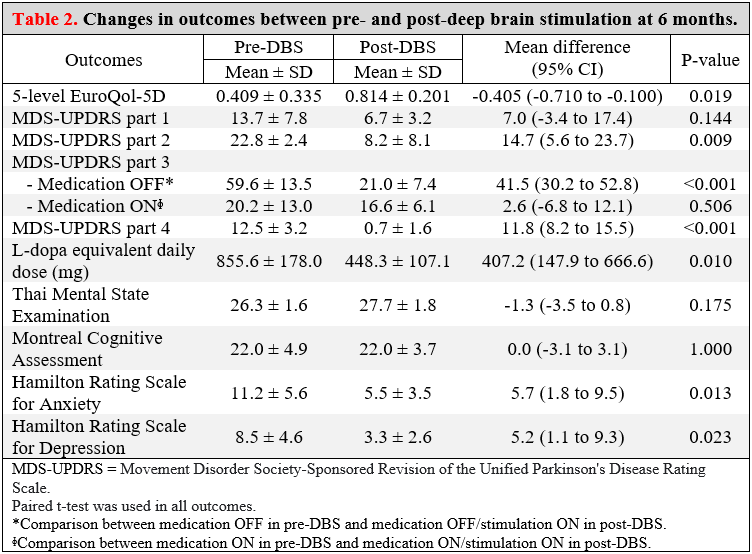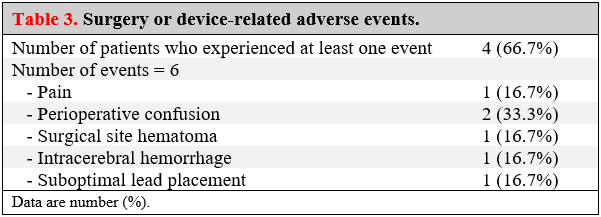Category: Surgical Therapy: Parkinson's Disease
Objective: To evaluate the efficacy and adverse events of subthalamic nucleus deep brain stimulation (STN-DBS) in Thai patients with Parkinson’s disease (PD).
Background: Bilateral STN-DBS has been known as the efficacious treatment for motor fluctuations and dyskinesia in advanced-stage PD [1]; however, there have been very few studies in Thailand [2].
Method: This is a pre- and post-DBS efficacy study. All PD patients in the Neurological Institute of Thailand who underwent DBS in 2022 were recruited. Clinical data was obtained at baseline with 2 conditions (‘OFF’ med/ ‘ON’ med) and 6-month post-DBS with 4 conditions (‘OFF’ med ‘ON’ stim/ ‘OFF’ med ‘OFF’ stim/ ‘ON’ med ‘OFF’ stim/ ‘ON’ med ‘ON’ stim). Primary outcomes were mean differences of 5-level EuroQol-5D (EQ-5D-5L) [3] and MDS-UPDRS part 3 in ‘OFF’ state (‘OFF’ med ‘ON’ stim). Secondary outcomes were mean differences of MDS-UPDRS part 3 in ‘ON’ state (‘ON’ med ‘ON’ stim), MDS-UPDRS part 1, 2, 4, L-dopa equivalent daily dose (LEDD), Thai Mental State Examination (TMSE), Montreal Cognitive Assessment (MoCA), Hamilton Rating Scale for Anxiety (HAM-A), and Depression (HAM-D). Adverse events were also assessed.
Results: A total of 6 patients with bilateral STN-DBS were recruited [table1], and the results showed that post-DBS, as compared with pre-DBS, had improvements in EQ-5D-5L and MDS-UPDRS part 3 in ‘OFF’ state with the mean score difference of 0.405 points (95% CI -0.710 to -0.100, p = 0.019) and 41.5 points (95% CI 30.2 to 52.8, p < 0.001), respectively [table2]. The mean MDS-UPDRS parts 2 and 4 were decreased by 14.7 points (95% CI 5.6 to 23.7, p = 0.009) and 11.8 points (95% CI 8.2 to 15.5, p < 0.001), respectively. The mean LEDD was decreased by 407.2 mg (95% CI 147.9 to 666.6, p = 0.010). Both mean HAM-A and HAM-D were decreased by 5.7 points (95% CI 1.8 to 9.5, p = 0.013) and 5.2 points (95% CI 1.1 to 9.3, p = 0.023), respectively. MDS-UPDRS part 3 in ‘ON’ state, MDS-UPDRS part 1, TMSE, and MoCA scores did not differ statistically. Adverse events occurred in 4 patients (67.7%), but all were not serious and resolved within 6 months [table3].
Conclusion: Our preliminary data showed that bilateral STN-DBS is effective and well-tolerated in improving health-related quality of life, motor impairment, and motor complications in Thai PD patients.
References: 1. Fox SH, Katzenschlager R, Lim SY, et al. International Parkinson and movement disorder society evidence-based medicine review: Update on treatments for the motor symptoms of Parkinson’s disease [published correction appears in Mov Disord. 2018 Dec;33(12):1992]. Mov Disord. 2018;33(8):1248-1266.
2. Nunta-Aree S, Sitthinamsuwan B, Boonyapisit K, Pisarnpong A. SW2-year outcomes of subthalamic deep brain stimulation for idiopathic Parkinson’s disease. J Med Assoc Thai. 2010;93(5):529-540.
3. Pattanaphesaj J. Health-related quality of life measure (EQ-5D-5L): measurement property testing and its preference-based score in Thai population [Doctoral dissertation]: Mahidol University; 2014.
To cite this abstract in AMA style:
S. Rujirussawarawong, C. Kasemsuk, T. Srikijvilaikul, N. Limotai. Efficacy of subthalamic nucleus deep brain stimulation in Parkinson’s disease: A preliminary Thailand experience [abstract]. Mov Disord. 2023; 38 (suppl 1). https://www.mdsabstracts.org/abstract/efficacy-of-subthalamic-nucleus-deep-brain-stimulation-in-parkinsons-disease-a-preliminary-thailand-experience/. Accessed December 30, 2025.« Back to 2023 International Congress
MDS Abstracts - https://www.mdsabstracts.org/abstract/efficacy-of-subthalamic-nucleus-deep-brain-stimulation-in-parkinsons-disease-a-preliminary-thailand-experience/



